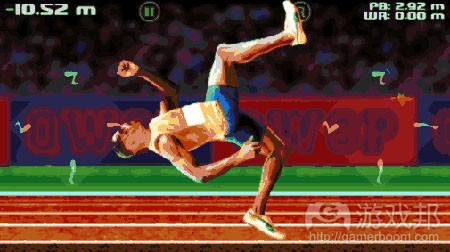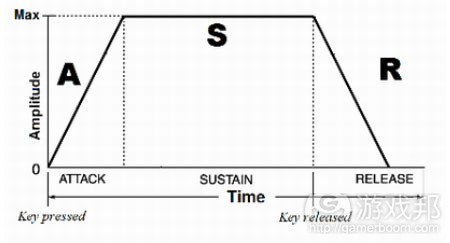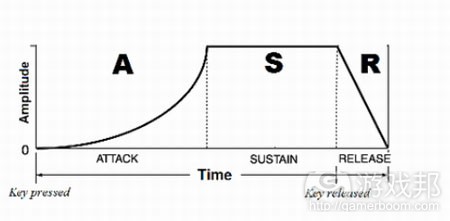Stephen Morris阐述游戏的直觉操作原理
作者:Stephen Morris
你是否曾经抱怨游戏延迟?也许问题的关键恰恰相反,不是游戏延迟了,而是游戏操作太灵敏了?人们经常谈论直觉操作,但到底什么才是直观操作?
在Jake Birkett发表的文章中,他探讨了手机游戏的各种操作方案的优缺点。
我希望进一步研究这个话题,并分析为什么某种操作方案是合适的。
感觉的延伸
当玩家玩电子游戏时,他们把所有注意力都放在4英寸屏幕上发生的事情上,忽略周围的一切。
游戏成为我们感觉的替代品:画面传递环境细节和危险信息、声音给我们重要的声音线索、隆隆的发动机声使我们体验到激烈的碰撞。
所有这些感觉都顽促成玩家在游戏中身临其境的体验。但如果玩家不能有效地操作游戏,这种体验就会被破坏。
体验被破坏意味着玩家不再沉浸于游戏世界。所以,玩家到底要怎么操作游戏,如何让操作更直观?
直觉操作的最佳定义是“玩家行动的意图转化为期望的现实。”
(《QWOP》是一款操作很迟钝的游戏。)
游戏越接近玩家的意图,玩家在游戏中的沉浸感就越强。如果游戏的操作太迟钝或太困难,玩家就会不耐烦,甚至最终失望地放弃游戏。
有些人偏好困难和迟钝的操作方法(游戏邦注:如Bennett Foddy的《QWOP》),但对于绝大多数玩家,还是喜欢清楚、简单、少延迟的操作方法。
内置处理器
在80年代,人们设计了一种人类处理器模型(认知模拟)来计算普通人认识、处理和执行思维作业需要花多长时间。
该项研究把人类认知过程分成三个关键环节:感觉、认知和行动。
感觉处理器负责接收来自我们的感觉器官的输入,并识别内部模式和进行一般化处理。然后,感觉处理器把结果数据传送给认知处理器——直接负责决定如何处理信息和下一步采取什么行动。再接着,行动处理器把信息转换为肌肉活动。
各个环节持续的时间如下:
感觉处理:约100毫秒(50~200毫秒)
认知处理:约70毫秒(30~100毫秒)
行动处理:约70毫秒(25~170毫秒)
玩家从观察到一个活动、决定怎么做到做出反应至少需要105毫秒(感觉50毫秒,认知30毫秒,行动25毫秒)。在实际情况中,还要看情势的紧张程度,普通人完成这个过程一般需要240毫秒。
这个顺序之后通常会形成一个修正的循环。当你的身体活动对屏幕上的行动做出反应时,你的身体行动会反馈给你的感觉处理器。认知处理器会产生另一套方案,之后肌肉活动会相应地修正动作。
我们用Mobirate/Chillingo的新游戏《Dead Ahead》作为例子。从画面上,我们可以看到主角正对着警车前进。
我们把拇指滑到右边,以便使角色避开警车。我们会这么做是因为我们在不断地评估形势和意图结果。
所以如果我们的修正循环是240毫秒,那么为什么游戏还要坚持每秒最少30帧?
这是因为人类处理器是同步运转的。当感觉处理器完成它的循环并传递信息时,它也再次观察感觉。
这意味着视觉的循环速度至少是100毫秒或每秒10帧——碰撞活动需要的最少时间。20fps接近于50毫秒,而30fps能使动作显得更加流畅。
这个处理系统也运用于游戏。它需要帧来接收输入,帧来处理,帧来更新它的“发动机”——都在最少50毫秒内发生。
如果是60fps,我们就有3帧来提供“瞬间的”反馈。游戏反应所需时间越长,反应延迟就越明显,玩家就觉得游戏越迟钝。
描绘反应曲线
现在, 我们已经道为什么需要保持高帧率,那么玩家的输入如何转化为行动?
当玩家按下跳跃键或向上键时,动作是否紧密?我们可以用一张曲线图,或称之为ADSR轨迹图来表示这个行动。
这条曲线可以分成四个部分:进攻、衰退、维持和释放。
攻击是从0上升到最大值的初始环节。衰退是从最大值下降到按键持续一段时间的阶段。最后,释放发生于当玩家松开按键时,或维持时间达到最大值时。
现在,我们如何定义紧密或松散的反应,并且如何使用它们?
我们以Terry Cavanagh的《Super Hexagon》为例子。
注意在这个例子中,进攻和释放时间比较短,表明反应是紧密的。因为《Super Hexagon》的本质特点,进攻阶段非常迅速,且在下一阶段来临前,动作维持了一段时间。
进攻和释放的时间短使游戏的“活泼”特点更加突出。
松散的反应表现如下:
如你所见,上升到最大值的速度非常慢。在快节奏的街机游戏中,反应力是相当重要的,进攻太慢不仅有害,甚至致命。
你偶尔可以在某些平台游戏上看到这种现象,但你更可能在例如《Asteroids》这样的游戏中遇到它。当你按下推进器时,它需要相当长的时间才能达到最大加速度。
总结
在反抗不能优化的材料和落后的硬件中,开发者不断地寻找所有多余的循环,我们现在知道,给玩家他们渴望的即时反馈是多么重要。
更重要的是,我们要根据玩家的期待,找到游戏元素反应事件的合适方式。
本文只是简介了操作方式如何促进或破坏游戏体验。在下一篇文章中,我将解释如何利用基本的操作方案来达到强化游戏沉浸感的这一期望目标。(本文为游戏邦/gamerboom.com编译,拒绝任何不保留版权的转载,如需转载请联系:游戏邦)
Best of British: Stephen Morris considers the split second timings needed for intuitive controls
by Stephen Morris
Ever cursed a game for being too laggy? Perhaps it was the opposite and the controls were too sensitive? People often talk about intuitive controls but what exactly does this mean?
In an earlier article, current Best of British chief Jake Birkett touched on the pros and cons for various control schemes available to mobile developers.
I wanted to take this a step further and analyse why do particular schemes feel appropriate.
Extending the senses
When a player handles a digital game, their senses become instantly focused on the events within the 4-inch screen to the exclusion of the surrounding environment.
The game acts as a surrogate for our senses: the visuals delivers the environmental details and hazards, the sounds gives us important audial clues, and the rumble motor can give us the required tactile experience of a heavy collision.
All of these senses contribute to delivering full immersion to the player but if the game can’t be controlled effectively, the experience is broken.
A broken experience means the player no longer feels engaged and instead switches over to something else. So exactly how does the player control the game and what makes it intuitive?
The best definition for intuitive controls is “the intent of player actions translated into the desired reality.”
QWOP – a game that makes a feature of obtuse controls
The closer the game can represent what the player meant to do, the more immersive the experience. If the game is slow or incredibly difficult to control, the more impatient the player gets and eventually gives up the game in frustration.
Some people revel in difficult and obtuse control schemes (see Bennett Foddy’s QWOP) but for the majority, they favour clear and easy controls with minimal response lag.
Internal processors
In the 1980s, the human processor model (a cognitive modeling method) was devised to calculate how long it takes an average person to identify, process and perform a mental task.
The research was able to break down human cognition into several key processing areas: perception, cognition and motor.
The perception processor was responsible for taking input from our senses and identifying internal patterns and generalisations. The resultant data would then be passed on to the cognitive processor – this is directly responsible for determining what to do with the information and next point of action. The next step would then be handled and converted into muscle movement by the motor processor.
The durations for each section could be broken down as follows:
Perceptual processing: ~100ms [50-200ms]
Cognitive processing: ~70ms[30-100ms]
Motor processing: ~70ms[25-170ms]
The absolute minimum time in which a player can observe an action, determine what to do and react is 95ms (perception 50ms, cognition 30ms and motor 25ms). This is based on intense circumstances but in reality, the average person would have a duration of 240ms.
This sequence of stages will then routinely loop and create a correction cycle. As your physical movements respond to the actions presented on screen, your physical actions are fed back into your perceptual processor. Alterations are decided upon and then muscles moved to fine-tune and correct the movement.
As an example, lets use Mobirate/Chillingo’s recent game Dead Ahead. Visually, we can see our protagonist is heading directly towards the monochrome police car.
We place our thumb on the right hand side and slide upwards to control our avatar out of harm’s way. The amount we do so is the result of continually assessing the situation and our intended result.
So if our correction cycle is 240ms, why do games insist on 30 frames per second minimum?
It’s because human processors run concurrently. Once the perceptual processor has finished its cycle and passed on the data, it observes the senses once again.
This means the visuals have to cycle at least at 100ms or 10 frames per second – the minimum required for the illusion of movement. 20fps will border on the 50ms boundary whereas 30fps will dip below, making movement seem much smoother.
This processing system also applies to the game. It needs a frame to take input, a frame to process and then a frame to update it’s ‘motors’ – all within the 50ms lower bounds.
At 60fps, this gives us the 3 frames required to provide ‘instantaneous’ feedback. The longer it takes for the game to respond, the higher the response lag and the more sluggish the player perceives the game.
Mapping the response curve
Now that we have identified the need for, and maintaining, a high frame rate, how do we translate a player’s input into movement?
When the player taps the jump button or swipes upwards, does the movement feel tight or floaty? We can represent this movement through the use of a curve graph or, specifically, an ADSR envelope.
The curve can be broken down into four distinct sections: Attack, Decay, Sustain and Release.
The attack is the initial rise from 0 to the maximum value. The decay will drop from the maximum value to a level that can be sustained for a duration of time with the button held down. Finally, the release occurs when the player releases the button or the maximum amount of sustain time has been reached.
So, how do we define tight and loose responses and where would we use them?
Here is an example for Terry Cavanagh’s Super Hexagon.
Notice in this example, the attack and release are relatively short indicating a tight yet responsive feel. Due to the nature of Super Hexagon, you would expect a fast attack phase and the movement sustained as you aim to position your ship between the upcoming gaps.
Making the attack and release shorter contributes to a more ‘skittish’ feel.
A loose response can be shown as thus:
As you can see, the ramp up to the expected maximum value builds up slowly. In a fast, arcade game where reactions are critical, an attack phase this gradual would be detrimental and possibly fatal.
You can sometimes see this in some platformers but you are more likely to have experienced it in games such as Asteroids. When you press the thrusters, it takes a relatively long time to reach maximum acceleration.
Final thoughts
As a developer trying to eek out every spare cycle in the fight against unoptimised assets or lagging hardware, we can now identify how important it is to give players the immediate response they crave for.
More importantly, it is also critical we match the manner in which elements respond to events according to the player’s expectations.
This article only scrapes the surface on how controls can make or break a game. In the next piece, I’ll dive into promoting the player immersion even further using the underlying control schemes to reach expected goals.(source:pocketgamer)
上一篇:手机游戏能否无视易用性设计原则?
下一篇:举例阐述触屏游戏控制方式的独特性












































 闽公网安备35020302001549号
闽公网安备35020302001549号